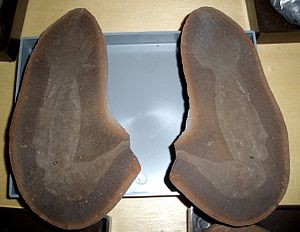Tullimonstrum
| Tullimonstrum | ||||||
|---|---|---|---|---|---|---|

Imprint of Tullimonstrum in the Museo Civico di Storia Naturale di Milano . Positive and negative side. The tail points upwards, the head lying below with the trunk inwards. |
||||||
| Temporal occurrence | ||||||
| Pennsylvania (Upper Carbon) | ||||||
| 309 to 307 million years | ||||||
| Locations | ||||||
|
||||||
| Systematics | ||||||
|
||||||
| Scientific name | ||||||
| Tullimonstrum | ||||||
| Richardson , 1966 | ||||||
| Art | ||||||
|
Tullimonstrum gregarium |
||||||
Tullimonstrum is an extinct animal from the Upper Carboniferous , whose systematic affiliation is puzzling ( incertae sedis ). Fossils of tullimonstrum were in the fossil deposit of Mazon Creek near Morris in Illinois found. It was named after its discoverer, the fossil collector Francis Tully, and is the state fossil of Illinois. Since then,thousands of fossils of the genus have been foundby professional paleontologists and amateur collectors.
The only species described is Tullimonstrum gregarium , the name 'common Tullimonstrum' referring to the frequent finds.
features
The fossils of Tullimonstrum have a body length of 15 to 43 centimeters, most specimens are between 31 and 35 centimeters long. Tullimonstrum had a spindle-shaped body with a diamond-shaped, vertical tail fin at the rear end. At the head end was a trunk, at the end of which was a jaw with 14 small, sharp teeth. The jaw was between 5.5 and 16.5 mm long and between 3.5 and 6 mm wide. The teeth were 0.5 to 2.4 mm in length. At the transition from the body to the trunk you can see a sickle-shaped structure, behind which are two stalked eyes. Tullimonstrum was a swimming, predatory animal that probably had a way of life similar to that of today's arrow worms .
Systematics
The systematic affiliation of Tullimonstrum is controversial and it has been suggested that it belongs to the conodonts , the molluscs , the cordworms or the annelid worms . Upon closer examination of more than 1200 fossils of the puzzling animal, a team of scientists found a notochord , gill pockets, muscle segments as in lampreys and other primitive chordates, and teeth that resemble those of lampreys and hagfish . Tullimonstrum is regarded by them as a primitive vertebrate . According to a phylogenetic analysis, it is at the base of the line that leads to the lampreys (Petromyzontiformes).
However, recent research casts doubt on this thesis. In 2017, a team led by Lauren Sallan from the University of Pennsylvania voiced criticism and postulated that Tullimonstrum does not necessarily have to be a vertebrate. On the one hand, the analysis of the eyes, which has so far been provided as evidence, would not have revealed any evidence of lens eyes, and since only soft tissue was preserved in the fossils, the claim of a hard spine could not be sufficiently proven. In addition, features such as complex eyes and teeth have also formed in some classes of invertebrates.
An even more recent study supports the assumption that the species is a vertebrate. Using Raman spectroscopy , scientists analyzed the chemical residues on the fossils and compared them with those of other vertebrate and invertebrate fossils in Mazon Creek. The examined tissue did not contain chitin , which is part of the exoskeleton in invertebrates , but did contain remains of proteins that make up the keratin and collagen of vertebrates.
literature
- Ralph Gordon Johnson, Eugene Richardson, Jr .: Pennsylvanian invertebrates of the Mazon Creek Area, Illinois: the morphology and affinities of Tullimonstrum . In: Field Museum of Natural History (ed.): Fieldiana. Geology . tape 12 , no. 8 , 1969, p. 119–150 , doi : 10.5962 / bhl.title.5171 ( archive.org ).
- Paul Selden , John Nudds: Window to Evolution - Famous Fossil Findings of the World , Elsevier Spectrum Academic Publishing House, Munich 2007, ISBN 978-3-8274-1771-8 .
Individual evidence
- ↑ Frank Patalong: Mysterious Fossil: Monster remains monster . In: Spiegel Online . February 21, 2017 ( spiegel.de [accessed June 3, 2018]).
- ↑ Victoria E. McCoy, Erin E. Saupe, James C. Lamsdell, Lidya G. Tarhan, Sean McMahon, Scott Lidgard, Paul Mayer, Christopher D. Whalen, Carmen Soriano, Lydia Finney, Stefan Vogt, Elizabeth G. Clark, Ross P. Anderson, Holger Petermann, Emma R. Locatelli, Derek EG Briggs: The 'Tully monster' is a vertebrate . In: Nature . tape 532 , no. 7600 , March 16, 2016, ISSN 0028-0836 , p. 496-499 , doi : 10.1038 / nature16992 .
- ↑ Lauren Sallan, Sam Giles, Robert S. Sansom, John T. Clarke, Zerina Johanson, Ivan J. Sansom, Philippe Janvier: The 'Tully Monster' is not a vertebrate: characters, convergence and taphonomy in Palaeozoic problematic animals . In: Palaeontology . tape 60 , no. 2 , February 20, 2017, ISSN 0031-0239 , p. 149-157 , doi : 10.1111 / pala.12282 .
- ↑ Victoria E. McCoy, Jasmina Wiemann, James C. Lamsdell, Christopher D. Whalen, Scott Lidgard: Chemical signatures of soft tissues distinguish between vertebrates and invertebrates from the Carboniferous Mazon Creek deposit of Illinois . In: Geobiology . n / a, n / a, ISSN 1472-4669 , doi : 10.1111 / gbi.12397 .
Web links
- The Paleobiology Database: Tullimonstrum
